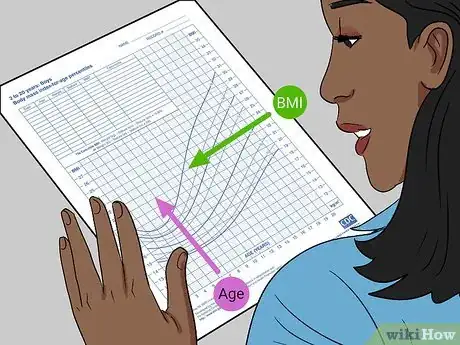This article was co-authored by Laura Marusinec, MD and by wikiHow staff writer, Jennifer Mueller, JD. Dr. Marusinec is a board certified Pediatrician at the Children's Hospital of Wisconsin, where she is on the Clinical Practice Council. She received her M.D. from the Medical College of Wisconsin School of Medicine in 1995 and completed her residency at the Medical College of Wisconsin in Pediatrics in 1998. She is a member of the American Medical Writers Association and the Society for Pediatric Urgent Care.
There are 10 references cited in this article, which can be found at the bottom of the page.
This article has been viewed 58,802 times.
The body mass index (BMI) provides an indication of whether a child is overweight or underweight, given their height, age, and biological sex. Knowing your child's BMI helps you determine what measures you should take to help the child develop a healthy and active lifestyle. Maintaining a BMI in the healthy range as a child can decrease the risk of serious health conditions in adulthood. To calculate a child's BMI, you must first measure the child's height and weight accurately. For children, the BMI is interpreted according to a growth chart that adjusts for a child's age and biological sex.[1]
Steps
Finding the Child's BMI
-
1Remove shoes or bulky clothing. While a light T-shirt or shorts are fine, heavy sweaters or jeans and shoes will prevent you from accurately measuring the child's height and weight. Any hair accessories that gather the child's hair on the top of their head also interfere with the height measurement.[2]
- Bulky clothing can interfere with an accurate height measurement as well as weight. For example, if the child is wearing a hoodie they won't be able to stand straight against a wall.
- You also might want to remove braids if they add height.
- Your purpose is to get accurate measurements, not to humiliate the child or make them uncomfortable. Allow them to cover their body in a way that won't interfere with your results.
-
2Measure the child's height. You can get an accurate measure of the child's height at home with a flat stick, a wall, and a measuring tape. Choose a location where the child can stand straight against the wall on an uncarpeted floor.[3]
- Have the child stand straight with their head, shoulders, buttocks, and heels against the wall, looking straight ahead. The child's heels should be together, their shoulders flat. Keep in mind that depending on the child's body shape, they may not be able to touch the wall with all of those body parts.
- Get a flat stick such as a ruler and place it against the wall at a right angle. Lower it until it firmly rests on the top of the child's head.
- Make a light mark with a pencil at the spot where the bottom of your stick hits the wall. You may want to have the child duck out from under it once you have the stick in place so you can make your mark.
- Using a metal tape measure, find the child's height by measuring the distance from the floor to the mark you made.
Advertisement -
3Weigh the child on a digital scale. To get an accurate measurement of your child's weight at home, place a digital scale on firm, even flooring such as tile or wood. Avoid scales that are spring-loaded for weighing children.[4]
- Make sure the child isn't wearing shoes, or any heavy or bulky clothing that could add weight to the result.
- Have the child stand straight up with both feet on the scale. You may want to have the child step off the scale and repeat the weighing twice more for the most accuracy, especially if the child is fidgety.
- If you weigh the child more than once, simply average the results.
-
4Record the child's measurements. As you measure the child, write down the results. To ensure the most accurate measurement, record the child's height to the nearest one-eighth of an inch (or 0.1 centimeter), and record the child's weight to the nearest decimal tenth.[5]
- Take measurements in the system with which you are most comfortable. Although BMI is measured using the metric system, most calculators will convert measurements recorded in pounds and inches.
-
5Enter the child's information into a BMI calculator. While you can calculate the child's BMI manually, it typically is much easier to find a BMI calculator online. All you have to do is provide the child's age, biological sex, and measurements.[6]
- You can find a reliable children's BMI calculator on the Centers for Disease Control and Prevention (CDC) website here: https://www.cdc.gov/healthyweight/bmi/calculator.html. Many state government and health insurance agencies also have reliable calculators.
- Ideally, you want to use a calculator on the website of a government agency or health care provider you trust. Don't use a calculator if the website is asking for your name, email address, or any other such information before giving you the results.
- The calculator will provide you with the child's BMI; however, unlike an adult BMI calculation, the child's specific BMI doesn't tell you much. You have to consult a chart to determine what that number means based on the child's age and biological sex.
- the manual calculation is as follows:
- BMI = weight in pounds / [height in inches x height in inches] x 703
- BMI = weight in kilograms / [height in meters x height in meters]
Interpreting the Child's BMI
-
1Find a BMI chart. To properly interpret a child's BMI, you must use a growth chart that provides a BMI index based on the age of children and teenagers. The BMI is expressed as a percentile, which measures the child's BMI relative to other children in the U.S.[7]
- The data used to create the official BMI charts was gathered through surveys conducted from 1963-1965 and 1988-94. Keep this in mind when interpreting the results.
- You can easily find a BMI chart online. Use a government website or a trusted health care provider. There are two different charts – one for boys and one for girls.
-
2Locate the child's percentile. To use the BMI growth chart, first find the child's age along the bottom of the chart, then find the child's BMI along the side. Use a piece of paper or other straight edge to find the point on the chart that corresponds with the child's BMI and age.[8]
- The CDC chart allows you to find the percentile for children, teenagers, and young adults from two years old to 20 years old.
- Generally, the child is considered underweight if their BMI falls below the 5th percentile.
- If the child's BMI is greater than the 5th percentile but below the 85th percentile, the child has a normal or healthy weight. You still should monitor the child's activities and eating, particularly if they fall at the upper end of that range.
- If a child has a BMI above the 85th percentile, but below the 95th percentile, they are considered overweight, and a child with a BMI above the 95th percentile is obese. If the child falls in these ranges, they are at risk for significant health problems.
-
3Consult a health care provider. In children, the BMI calculation is not considered a diagnostic tool. If your measurements indicate that the child is either overweight or underweight, take the child to a doctor for further testing and analysis.
- Occasionally, an older child with significant muscle mass may appear overweight on a BMI calculation when they are not. The doctor can help determine if the child is overweight or not.
- Let the doctor know the results of your measurement and interpretation, and schedule an appointment. The doctor may want to take skinfold thickness measurements or others to confirm your interpretation.
- If your interpretation shows that the child is significantly over- or underweight, the doctor may want to complete additional screenings to ensure the child does not have any health conditions as a result.
- The doctor also will likely conduct a complete evaluation of the child's diet, activities, and family medical history.
Applying the Results
-
1Encourage healthy eating. Whether the child is over- or underweight, a healthy, balanced diet will put the child on the right track to healthy weight management, as well as building habits the child can carry with them into adulthood.[9]
- Provided the child isn't lactose-intolerant or allergic, make sure their diet includes two to three servings of low-fat milk and dairy products each day.
- Offer your child plenty of fruits and vegetables.
- Limit foods with saturated fats.
- Serve reasonable portions — the size of the child's fist is a good "rule of thumb" to measure portion sizes generally.
- Read ingredient labels carefully, particularly on processed or packaged foods. Avoid those that contain lots of chemicals and added sugars. Most processed foods should only be eaten occasionally.
- Choose lean meats such as chicken and turkey, and limit consumption of red meat.
- Avoid sodas and fruit juice drinks with added sugar. Instead, offer water, milk and natural fruit juices.
-
2Remove junk food and other temptations. If you have sweets and snacks in the house, the child will eat them. Replace candies, cookies, and salty snacks like chips and crackers with plenty of fresh fruit and vegetables.[10]
- You don't have to spend a lot of money to give children healthy snacks. Buy healthy grains and nuts in bulk and mix them together to make your own trail mix. You also can buy whole vegetables and cut them yourself and divide them into snack-size portions.
- Keep individually portioned bags of healthy snacks in the front of the fridge so anyone can grab them easily.
- Keep in mind that children learn from parents and adults. Teaching the children in your home to eat healthy means the adults need to eat healthy too. The children will emulate the adults.
-
3Provide an underweight child with protein-rich foods. If the child's BMI indicated they were underweight for their age, foods that have healthy fats and are full of protein will help the child build strong muscles and bones and encourage the child to gain weight.[11] Talk to your child's doctor or a dietitian for specific dietary instructions for your child's needs.
- Full-fat milk is better for underweight kids than low-fat or skim milk. Hummus and bean dips also provide a good mix of protein and healthy fat.
- Whole wheat breads and pastas are good sources of carbohydrates for kids who are underweight.
- Nuts, seeds, and avocados also are good sources for healthy fats that will help an underweight child gain weight.
- To encourage an underweight child to eat, especially if they are a picky eater, make mealtime a pleasant experience. Don't rush the experience, and involve the child in meal preparation.
-
4Add physical activity to your daily routine. Ideally, children should engage in at least one hour of moderately intense physical activity every day. Making physical activity a part of the daily routine for the entire family means children will be more likely to get involved.[12]
- For example, you may start a daily habit of going for a walk as a family after dinner each evening.
- When you think of moderately intense activity, focus on things that will make your child breathe harder and make their heart beat faster. They shouldn't be gasping for breath.
- For example, walking the dog is an activity of moderate intensity. Running around playing tag is more of a vigorous-intensity activity.
- If you have the means to do so, adopting a dog can be a great way to ensure everyone in the family leads a more active lifestyle. Walking the dog or playing with the dog outside all are moderate-intensity activities. Taking care of a pet also teaches a child discipline and responsibility.
-
5Limit screen time. Between television, computers, tablets, and smartphones, many children live relatively sedentary lifestyles in which too much time is spent in front of a screen. Monitoring and rationing this time can help encourage the child to be more active.[13]
- Pediatric health experts recommend limiting children's screen time to no more than two hours each day. This may be a difficult limit to maintain, however, if the child is older or has a homework assignment that requires using the internet.
- When children are sitting for an extended period of time, whether they are working on homework or playing a video game, encourage them to stand and move around every 20 minutes or so, even if it's only to get up and do jumping jacks for five minutes.
-
6Enroll the child in age-appropriate activities. School and community sports and other activities keep the child active. The child also can learn important lessons about teamwork, discipline, and responsibility.[14]
- Swimming and soccer are two activities that promote full-body fitness and overall strength.
- Gymnastics or dance classes teach important life skills such as discipline and focus while also giving a child a good whole-body workout.
- Some classes and sports can be relatively expensive compared to others, so make sure the activity fits in your budget before you introduce it to the child.
References
- ↑ http://www.cdc.gov/healthyweight/assessing/bmi/childrens_bmi/about_childrens_bmi.html
- ↑ https://www.aboutkidshealth.ca/article?contentid=3910&language=english
- ↑ https://www.aboutkidshealth.ca/article?contentid=3910&language=english
- ↑ https://www.aboutkidshealth.ca/article?contentid=3910&language=english
- ↑ http://www.cdc.gov/healthyweight/assessing/bmi/childrens_bmi/measuring_children.html
- ↑ https://www.healthychildren.org/English/health-issues/conditions/obesity/Pages/Body-Mass-Index-Formula.aspx
- ↑ http://www.cdc.gov/healthyweight/assessing/bmi/childrens_bmi/about_childrens_bmi.html
- ↑ http://www.cdc.gov/healthyweight/assessing/bmi/childrens_bmi/about_childrens_bmi.html
- ↑ https://kidshealth.org/en/parents/habits.html
- ↑ http://www.cdc.gov/healthyweight/children/index.html
- ↑ http://www.eatright.org/resource/health/weight-loss/your-health-and-your-weight/safe-weight-gain-tips-for-underweight-kids
- ↑ https://www.healthychildren.org/English/healthy-living/fitness/Pages/Encouraging-Your-Child-to-be-Physically-Active.aspx
- ↑ https://www.healthychildren.org/English/healthy-living/fitness/Pages/Encouraging-Your-Child-to-be-Physically-Active.aspx
- ↑ http://www.cdc.gov/physicalactivity/basics/children/index.htm














-Step-14-Version-3.webp)




















-Step-14-Version-3.webp)






































